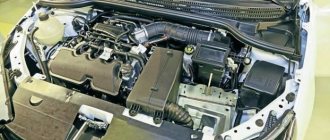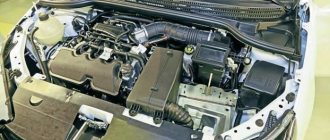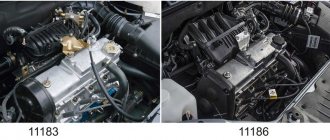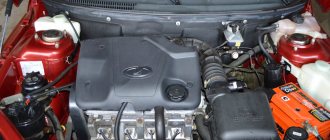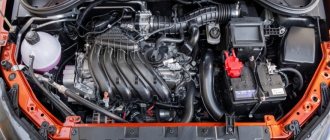Category: ENGINE
- Engine characteristics 21129
- Engine design 21129
- Gas distribution mechanism
- Cooling system
- Electricity supply
- Lubrication system
- Advantages and disadvantages
- Engine Maintenance 21129
- Tuning the Largus engine and other models with engine 21129
Starting from 2013, engine 21129 was put into mass production. The power unit is a modernized version of model 21127. The engine is intended for use on Lada X Ray, Lada Vesta, Lada Largus. Compared to the previous model of the power unit, the motor has higher power and environmental friendliness.
Engine characteristics 21129
The engine of the Lada X-ray and other models is unpretentious to operating conditions and fuel quality. The motor has the following technical characteristics:
- Power unit brand - 21129;
- Type of power plant - injection;
- Number of working cycles - 4;
- Number of working cylinders - 4;
- The number of timing valves per cylinder is 2 exhaust and 2 intake;
- The cylinder block is cast iron;
- The piston stroke from top to bottom dead center is 75.6 millimeters;
- Working cylinder diameter - 8.2 cm;
- Power plant volume - 1596 cm3;
- Compression – 10.5;
- The maximum power of the power unit is 106 horsepower;
- Connecting rod length - 133 mm;
- The fuel used is gasoline;
- Compliance with environmental standards - Euro 5;
- The operating order of the cylinders is 1,3,4,2;
- Curb weight of the power plant - 109 kg;
- The oil volume in the crankcase of the power unit is 3.2 liters;
- Engine life 21129 - 200,000 km;
- Average gasoline consumption is 6.6 liters per 100 km.
REFERENCE: the moving parts of the power unit are lubricated with motor oil with a viscosity grade from 0W-30 to 15W-40. The manufacturer recommends using oil with a viscosity of 5W40 and 5W30 for lubrication.
Lada Largus suspension
The chassis of the Lada Largus is simple and reliable, and does not cause any major complaints from car owners. Some Largus owners load the car with up to one ton of cargo, and the suspension adequately withstands the load. It’s surprising that no one complains about the reinforced rear springs; apparently, regardless of the weight of the load, they do not sag or break. At least on this car, failure of the rear springs is not a typical “disease”.
Over time, the first things to begin to “give” are the stabilizer struts, steering ends and ball joints. But even on “workhorses”, repairs to the chassis are usually required after a run of 100 thousand km; the “original” hub bearings last a long time. Many drivers carry out suspension repairs themselves, saving their money.
Gas distribution mechanism
The intake of the working mixture and the release of exhaust gases is carried out by a valve mechanism. Each working cylinder is equipped with two inlet and two exhaust valves. To control the valves, two cam-type camshafts are provided. The camshafts are driven by a belt, from a pulley mounted on the engine crankshaft.
To prevent lubricant from entering the cylinder during operation of the power unit, the valves are equipped with valve stem seals. To improve gas distribution, the manufacturer provides hydraulic compensators.
Renault company recommendations
If you haven’t found Elf Solaris Rnx on sale or you’re not satisfied with the price, then choose one of those oils recommended by Renault to fill in your Lada Largus. These are brands such as:
- Shell PC 1448 0W30, PC 1021 0W30 - low-viscosity all-season oils (may need to be replaced with a more viscous lubricant if you live in a hot climate) on a synthetic basis, recommended only for 8-valve engines;
- ELF Solaris MSX 5W-30, ELF Excellium NF 5W-40, ELF Evolution SXR 5W40 – more viscous fuels and lubricants compared to the previous ones;
- Lukoil Genesis RN 5W40 is a domestic oil of moderate viscosity.
Cooling system
The motor is equipped with a forced-type liquid cooling system. Cooling of the liquid is carried out in the radiator. The movement of coolant in the radiator and cooling jacket is carried out using a water pump. It is belt driven from the crankshaft of the power unit.
For quick warm-up in the cold season, a thermostat is included in the cooling system. At low coolant temperatures, the thermostat closes a large circulation circle. This allows for rapid heating of the coolant. Once the required temperature is reached, the thermostat opens a large circle.
IMPORTANT: The manufacturer has equipped the power plant with cooling of the working mixture. This design allows you to increase power and reduce fuel consumption.
Body of Lada Largus
The body paint raises a lot of complaints:
- the paintwork is thin and scratches quickly;
- Sometimes debris is found under the varnish;
- there are “shagreen” areas on the paintwork;
- On some cars, over time, the paint flies off in pieces (for example, in the area of the rear wheel arches or along the edges of the doors).
The gaps between body parts are not always even; after all, Russian assembly is still far from world class. After 2-3 years of operation, rust appears at the junctions of the sills and on the windshield frame. Of course, this is depressing, but there is no escape from the facts. Despite the “saffron milk caps” that appear, there are also positive aspects here - the body iron as a whole does not rot, and no through corrosion is observed.
Electricity supply
The power plant is controlled by an electronic unit. The microprocessor of the unit receives information from sensors, on the basis of which it controls the power plant. The engine is powered by a battery and a DC generator.
When the engine is switched off, the power supply is supplied by the battery. The battery voltage is 12 volts. The negative wire is connected to the motor housing. After starting the engine, the consumers are powered by a DC generator.
The DC generator powers the engine ignition system and charges the battery. The generator is driven by a belt, from a pulley mounted on the crankshaft. To avoid voltage surges, a regulator relay is included in the circuit.
Advantages and disadvantages
The engine of the Lada X-ray and other models is reliable. The motor has the following advantages:
- Saving fuel and lubricants. The 21129 engine has low fuel and lubricant consumption. Such indicators were achieved thanks to the new firmware;
- Increased power. The maximum engine power is 106 horsepower. When tuning, it is possible to increase this figure;
- Compliance with European environmental standards. More complete combustion of fuel in the chamber allows not only to improve technical performance, but also to increase the environmental class to the Euro 5 standard;
- Improved additional equipment. The manufacturer installed a modernized DC generator and improved mounting pads on the engine of the Lada X-ray and other models;
- Reliability and service life of the engine 21129. The manufacturer declared the service life of the power plant to be 200,000 km.
The power plant has shortcomings. These include:
- Bending of valves when the timing belt breaks.
- When the belt breaks, the piston, moving to top dead center, bends the open valves;
- High cost of communication maintenance and repair due to the presence of expensive foreign-made parts;
- Poor quality of the cooling system thermostat. The engine takes a long time to warm up in the winter;
- The need to use high-quality fuel and expensive lubricants.
Features and differences of the engine
The VAZ 21129 engine is based on the 21127 model, which is installed on the Lada Granta, Kalina, Priora models. Both engines differ from previous VAZ models by a modernized air intake system. Instead of a mass air flow sensor (MAF), absolute pressure (ABP) and air temperature (ATV) sensors are used. A system of dampers is used to regulate the length of the intake manifold, which allows the engine to operate optimally at both low and high speeds.
Improvements to the VAZ-21129 also included increasing the rigidity of the cylinder block, lubrication system, fuel injection, mounting of additional units, engine mount, exhaust system and a set of engine control elements. The new engine is designed for Euro-5 and adapted for manual transmission from Renault.
The engine uses a lightweight connecting rod and piston group. Short skirt pistons are cast from aluminum alloy. There are four small recesses in the bottom of each piston for the valve plates, but they do not prevent the valve from contacting the piston in the event of a timing violation or a broken timing belt.
Each piston has two compression rings and one oil scraper ring. All rings are thinner than on previous engine models, which is designed to reduce internal engine friction losses.
Tuning the VAZ 21129 engine (using the example of the sports version of Vesta) without installing a turbine and compressor allows you to increase power from 106 to 150 hp.
VAZ-21129 engine in section: 1 — drain plug of the oil pan; 2 - crankshaft; 3 - oil filter; 4 - catalytic manifold; 5 — coolant pump; 6 - piston; 7 — manifold cat. gasket; 8 — oxygen concentration sensor; 9 — spark plug; 10 — exhaust valve; 11 — cylinder head; 12 — exhaust camshaft; 13 — camshaft bearing housing; 14 — cylinder head cover (cylinder head); 15 — intake module; 16 — inlet valve; 17 — ignition coil; 18 — hydraulic pusher; 19 — intake camshaft; 20 — nozzle; 21 — fuel rail; 22 - damper; 23 — cylinder head gasket; 24 — piston rings; 25 — piston pin; 26 — cylinder block; 27 — fitting for the crankcase ventilation system; 28 — connecting rod; 29 — connecting rod bearings; 30 - flywheel; 31 — oil pan gasket; 32 — oil intake; 33 — engine sump.
Engine Maintenance 21129
For normal operation of the Lada Vesta and other models, it is necessary to carry out regular maintenance. For this:
- After covering 10,000-15,000 kilometers, it is necessary to replace the lubricant. The oil filter is replaced at the same time as the oil;
ATTENTION: Before changing the lubricant, you must warm up your unit. This will reduce the viscosity of the oil and speed up the draining process.
- After every 20,000 mileage, you should check the functionality of the spark plugs, DC generator drive belt, battery, and crankcase ventilation;
- When the Lada Xray and other models reach 45,000 mileage, it is necessary to check the functionality of the thermostat, the elasticity of the cooling system pipes and replace the antifreeze. Fuel filters are being replaced;
- After 100,000 miles, it is necessary to check the condition of the timing belt. If there is damage, a new belt should be installed.
What kind of oil was filled in the engine from the factory?
Both the 8 valve (K7M) and the 16 valve (K4M) at AvtoVAZ are filled with new synthetic oil ELF 5W-30 RN0700 . Salespeople at a car dealership will also recommend this oil to you. Classification according to ACEA A5/B5 - according to API SL/CF.
Judging by many surveys on websites dedicated to servicing Largus, many adhere to these recommendations.
But you can use other oil. The main thing is that it corresponds to the quality class and viscosity level specified in the instruction manual. ASEA oil class - A1, A2, A3 and A5; by API - SL, SM and SN.
Leaders include Shell, Lukoil and Zic.
Tuning the Largus engine and other models with engine 21129
Modernization of power plants makes it possible to achieve higher technical characteristics. Improving engine performance is carried out in specialized workshops that have the appropriate equipment. For this purpose, specialists:
- The sleeves are bored to a diameter of 88 mm. This enlarges the combustion chamber;
- Lightweight pistons are installed;
- Smooth out irregularities in the intake and exhaust channels;
- Modernize the gas distribution mechanism;
- Flashing the electronic control unit.
IMPORTANT: The firmware of the electronic control unit is performed by highly qualified specialists. Violation of this rule can lead to complete failure of the product and costly repairs.
From the above it follows that the 21129 engine installed on the Lada Largus and other models is distinguished by its reliability and power. The manufacturer equipped the power plant with new attachments. By performing tuning, they improve the technical characteristics of the engine.
History of the brand
There were no decent Russian-made cargo-passenger station wagons at the time of Largus’ creation, so the relevance of such a model is difficult to underestimate. The VAZ-2111 was already outdated by that time, did not have high cross-country ability, and, moreover, was always considered as a family car and was rarely used for commercial purposes. Another obsolete GAZ 310221 also could not compete - the “gluttony” of the clumsy “Volga” completely crossed out all its positive qualities. Russia needed a new reliable, practical and inexpensive station wagon, and in 2008 AvtoVAZ began developing such a model.
Photo: lada.ru
The debut project of joint cooperation between the Volzhsky Automobile Plant and the Renault-Nissan concern was made public in 2010; the new Lada Largus was first shown at the Moscow Motor Show. Volga residents began mass production in June 2012, and the start of sales was announced on July 16. At that time, a car could be bought from 319 thousand rubles; the basic configuration included a Renova 8-valve K7M engine with a 5-speed gearbox. "mechanics". Since the end of 2015, this engine has been replaced by the domestic VAZ-11189 power unit, which was supposed to reduce the cost of the design. But the price has only grown over the past three years, and in 2016 the minimum cost of Largus is already 524.5 thousand rubles.
Photo: autoleak.ru
